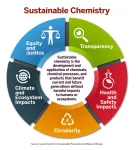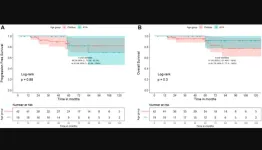(Press-News.org) How Common Is Face Blindness?
Study suggests condition affects more people than previously thought
For Immediate Release
Media Contacts:
Dennis Nealon
Dennis_Nealon@hms.harvard.edu
508-494-6117
Ekaterina Pesheva
Ekaterina_Pesheva@hms.harvard.edu
617-432-0441
At a Glance:
Study by researchers at Harvard Medical School/VA Boston Healthcare System suggests that face blindness lies on a continuum and may be more common than currently believed.
The study found similar face matching performance between prosopagnosics diagnosed with stricter vs. looser criteria, suggesting that the diagnostic criteria should be expanded.
As many as 1 in 33 people may meet the criteria for face blindness: 1 in 108 have major prosopagnosia whereas 1 in 47 have mild prosopagnosia.
Face blindness, a mystifying condition that can trick us into believing we recognize people we’ve never met or make us fail to recognize those we have, has been previously estimated to affect between 2 and 2.5 percent of people in the world.
Now, a new study by researchers at Harvard Medical School (HMS) and the VA Boston Healthcare System is providing fresh insights into the disorder, suggesting it may be more common than currently believed.
Published in February 2023 in Cortex, the study findings indicate that as many as one in 33 people (3.08 percent) may meet the criteria for face blindness, or prosopagnosia. This translates to more than 10 million Americans, the research team said.
The study found similar face-matching performance between people diagnosed with prosopagnosia using stricter vs. looser criteria, suggesting that diagnostic criteria should be expanded to be more inclusive. That could lead to new diagnoses among millions who may have the disorder but don’t realize it.
In the new study, led by Joseph DeGutis, HMS associate professor of psychiatry at VA Boston, the researchers found that face blindness lies on a spectrum — one that can range in severity and presentation — rather than representing a discrete group. The authors also provide diagnostic suggestions for identifying mild and major forms of prosopagnosia based on guidelines for major and mild neurocognitive disorders in the DSM5, the 5th edition of the Diagnostic and Statistical Manual of Mental Disorders.
The study results are based on a web-based questionnaire and tests administered to 3,341 individuals. First, the researchers asked participants whether they experience difficulties recognizing faces in their everyday lives. Then they administered two objective tests to determine whether they had difficulties learning new faces or recognizing highly familiar, famous faces.
The results showed that 31 individuals out of the 3,341 had major prosopagnosia, while 72 of the 3,341 had a milder form. The researchers also observed that there were no neatly divided discrete groups of people with poor or good ability to recognize faces. Rather, the ability to recognize faces appeared to lie on a continuum, they said.
Finally, the researchers compared face-matching scores among people with prosopagnosia diagnosed using different criteria and found that using stricter diagnostic cutoffs did not correspond with lower face-matching scores.
Harvard Medicine News spoke with DeGutis, the study’s senior author, about the implications of the findings.
Harvard Medicine News: Let’s start with the basics. What causes face blindness?
DeGutis: Prosopagnosia, or face blindness, can be caused by a brain injury to occipital or temporal regions, referred to as acquired prosopagnosia, which affects one in 30,000 people in the United States. Prosopagnosia can also be a lifelong condition caused by genetic or developmental abnormalities, referred to as developmental prosopagnosia, affecting one in 33 people.
HMNews: This is a fascinating condition, but some might say that it’s not a serious health disorder so why is it important to study and understand it?
DeGutis: First, face blindness can be a socially debilitating disorder that can limit employment opportunities. For example, networking is extremely difficult for people with prosopagnosia and can cause social distress and embarrassment. Recognizing someone is a social signal, indicating that “you are important to me.”
Prosopagnosia can also affect individuals on the autism spectrum and can be a consequence of age-related cognitive decline as well. In a world where social isolation is on the rise, especially in teens and young adults, fostering and maintaining social bonds and good face-to-face interactions are more important than ever.
HMNews: What sparked your interest in this field? What is it about how the brain sees and remembers faces intrigues you the most and why?
DeGutis: Face blindness is fascinating on several levels. Humans are remarkably good at recognizing familiar faces and this is done with very little effort. We know that this face ‘super-power’ relies on several specific perceptual processes: holistic face processing-seeing the face as an integrated whole, for instance; memory processes, readily associating faces with person-related knowledge; and specialized brain mechanisms and regions, too, such as the fusiform face area.
Our knowledge about face recognition in unimpaired individuals provides a very solid framework to understand the ways these processes can break down in prosopagnosia. The processes also provide clues on how to improve face recognition in people with face blindness, which is one of the major goals of our lab. Finally, studying prosopagnosia is fascinating from a phenomenological perspective—what do people with face blindness actually “see” when looking at a face? What comes to mind when they think about a familiar friend’s face?
HMNews: You say that your findings call for an expansion of the diagnostic criteria. Why is that important?
DeGutis: This is important on several levels. First, the majority of researchers have used overly strict diagnostic criteria and many individuals with significant face- recognition problems in daily life have been wrongly told they do not have prosopagnosia. Expanding the diagnosis is important because knowing that you have real objective evidence of prosopagnosia, even a mild form, can help you take steps to reduce its negative impacts on daily life, such as telling consequential coworkers, or seeking treatment.
Recent evidence suggests that people with milder forms of face blindness may benefit more from certain treatments than people with more severe forms of the condition. These treatments might include cognitive training to enhance perceptual abilities or training aimed directly at improving face associations.
Finally, factors such as age-related cognitive decline and social anxiety can further worsen face recognition abilities. Knowing if you have mild prosopagnosia could help you keep an eye out for further situational or age-related declines in face-recognition ability.
HMNews: What do you want clinicians and individuals with the condition to take away from these results?
DeGutis: The take-home message is that prosopagnosia lies on a continuum and stricter vs. looser diagnostic criteria employed in prosopagnosia studies in the past 13 years have identified mechanistically very similar populations, providing justification for expanding the criteria to include those with milder forms of it.
Another take-home message is the importance of using a combination of self-reported daily-life difficulties and validated objective measures when diagnosing prosopagnosia. There are pros and cons to relying just on self-reports because it can be challenging to judge your own abilities or relying solely on objective lab measures that may not reflect everyday life.
Authorship, funding, disclosures
Additional authors included Kanisha Bahierathan, Katherine Barahona, EunMyoung Lee, Travis Evans, Hye Min Shin, and Jirapat Likitlersuang of Harvard Medical School and VA Boston Healthcare System; Maruti Mishra of the University of Richmond; and Jeremy Wilmer of Wellesley College.
This study was supported by a National Eye Institute grant awarded to Joseph DeGutis (R01EY026057).
The authors have no disclosures to report.
Harvard Medical School has more than 11,000 faculty working in the 11 basic and social science departments comprising the Blavatnik Institute and at the 15 Harvard-affiliated teaching hospitals and research institutes: Baker Center for Children and Families, Beth Israel Deaconess Medical Center, Boston Children’s Hospital, Brigham and Women’s Hospital, Cambridge Health Alliance, Dana-Farber Cancer Institute, Harvard Pilgrim Health Care Institute, Hebrew SeniorLife, Joslin Diabetes Center, Massachusetts Eye and Ear/Schepens Eye Research Institute, Massachusetts General Hospital, McLean Hospital, Mount Auburn Hospital, Spaulding Rehabilitation Hospital, and VA Boston Healthcare System.
This release was written by Dennis Nealon
END
How common is face blindness?
Study suggests condition affects more people than previously thought
2023-02-27
ELSE PRESS RELEASES FROM THIS DATE:
Midwifery care safe for moderate- and high-risk pregnancies
2023-02-27
New UBC research shows that midwives in British Columbia are providing safe primary care for pregnancies of all medical risk levels, contrary to a popular belief that midwives mostly manage low-risk pregnancies.
The study, published in the Canadian Medical Association Journal, examined a decade of births in B.C. between 2008 and 2018. The researchers compared birth outcomes for people who had a midwife as their most responsible provider (MRP), with those who were cared for by a family physician or obstetrician.
The findings reveal that people who had a ...
Sustainable chemistry experts create blueprint for safer future
2023-02-27
Feb. 27, 2023
Media contacts:
Emily Gowdey-Backus, director of media relations, Emily_GowdeyBackus@uml.edu
Nancy Cicco, assistant director of media relations, Nancy_Cicco@uml.edu
Sustainable chemistry experts create blueprint for safer future
Group to share its work during free UMass Lowell webinar on March 1
Toxic chemicals – which pop up in everything from household cleaners and appliances to medical devices, paints, packaging and more – are all around. The February ...
Early-life stress can disrupt maturation of brain’s reward circuits, promoting disorders
2023-02-27
Irvine, Calif., Feb. 27, 2023 — A new brain connection discovered by University of California, Irvine researchers can explain how early-life stress and adversity trigger disrupted operation of the brain’s reward circuit, offering a new therapeutic target for treating mental illness. Impaired function of this circuit is thought to underlie several major disorders, such as depression, substance abuse and excessive risk-taking.
In an article recently published online in Nature Communications, Dr. Tallie Z. Baram, senior author and UCI Donald Bren Professor and Distinguished Professor in the Departments of Anatomy & Neurobiology, ...
Cedars-Sinai’s efforts to combat lower back pain get $2 million boost from CIRM
2023-02-27
Investigators at Cedars-Sinai have received a $2 million grant from the California Institute for Regenerative Medicine (CIRM) to develop a new cell therapy that helps improve quality of life for patients with degenerated discs and chronic lower back pain.
Dmitriy Sheyn, PhD, assistant professor in the departments of Orthopaedics, Surgery and Biomedical Sciences at Cedars-Sinai leads this new project in collaboration with Debiao Li, PhD, director of the Biomedical Imaging Research Institute and professor of Biomedical Sciences and Imaging at Cedars-Sinai; and Hyun Bae, MD, professor of Orthopaedics and co-medical ...
Amazon develops algorithm to improve collaboration between robots and humans
2023-02-27
New Study Key Takeaways:
A new algorithm is identified to allow robots and humans to work together efficiently and profitably.
Robots bring shelves of inventory to associates to pick for customer orders.
The adoption of the algorithm cuts down on distance traveled by pods as well as the storage footprint for the company.
The fulfillment operation with the new algorithm results in a half a billion dollars in savings.
BALTIMORE, MD, February 27, 2023 – Amazon has identified a financially beneficial way for robots and humans to coexist, and it’s saving the online enterprise half a billion dollars per year. Using robots to bring ...
Oncotarget | WNT-pathway medulloblastoma: What constitutes low-risk and how low can one go?
2023-02-27
“The definition of low-risk WNT-pathway medulloblastoma may need to be refined in light of recent clinical data and newer biological information.”
BUFFALO, NY- February 27, 2023 – A new research perspective was published in Oncotarget's Volume 14 on February 7, 2023, entitled, “WNT-pathway medulloblastoma: what constitutes low-risk and how low can one go?”
Novel biological insights have established that medulloblastoma is a heterogenous disease comprising four broad molecular subgroups - WNT, SHH, Group 3, and Group 4 respectively, resulting in the incorporation of molecular/genetic information in 5th edition ...
Rutgers researchers use artificial intelligence to predict cardiovascular disease
2023-02-27
Researchers may be able to predict cardiovascular disease – such as arterial fibrillation and heart failure – in patients by using artificial intelligence (AI) to examine the genes in their DNA, according to a new Rutgers study.
“With the successful execution of our model, we predicted the association of highly significant cardiovascular disease genes tied to demographic variables like race, gender and age.” said Zeeshan Ahmed, a core faculty member at the Rutgers Institute for Health, Health Care Policy and Aging ...
To promote exercise, planners must look beyond cities
2023-02-27
ITHACA, N.Y. – To encourage more active lifestyles, public health agencies recommend mixed-use neighborhoods and “complete” streets that are friendlier to walkers and bikers, but new Cornell University research finds that while those strategies increase physical activity, an urban bias limits their applicability in many parts of the country.
Planners in suburban and rural communities should focus more on promoting recreational programs, expanding transportation options and creating safer environments to help an aging population get more exercise, according to the researchers’ analysis of more than 1,300 U.S. counties and cities.
“These ...
Shrinking age distribution of spawning salmon raises climate resilience concerns
2023-02-27
By returning to spawn in the Sacramento River at different ages, Chinook salmon lessen the potential impact of a bad year and increase the stability of their population in the face of climate variability, according to a new study by scientists at UC Santa Cruz and NOAA Fisheries.
Unfortunately, spawning Chinook salmon are increasingly younger and concentrated within fewer age groups, with the oldest age classes of spawners rarely seen in recent years. The new study, published February 27 in the Canadian Journal of Fisheries and Aquatic Sciences, suggests changes in hatchery practices and fishery management ...
Ipek receives funding to write book on everyday life of activism in Lebanon
2023-02-27
Yasemin Ipek, Assistant Professor, Global Affairs Program, received funding to write a book on diverse meanings and implications of being an activist in Lebanon.
The book, titled: "Crisiswork: Activism, Class-Making, and Bounded Futures in Lebanon," will be a study of the emergent forms of activism and political subjectivity in contemporary Lebanon in relation to lived experiences of crisis.
Ipek aims to answer the question: "How has the recent mobilization of civil society activism shaped politics and everyday life in Lebanon?"
She intends to answer that question by ethnographically studying activism as a contentious ...
LAST 30 PRESS RELEASES:
Australian team discover why quantum computers have memory problems over time
What determines the fate of a T cell?
Candida auris: genetic process revealed which could be treatment target for deadly fungal disease
Groundbreaking discovery turns household plastic recycling into anti-cancer medication
Blocking a key inflammatory pathway improves liver structure and vascular function in cirrhosis, study finds
Continuous spread: Raccoon roundworm detected in nine European countries
HKUST Engineering researchers developed a novel photodetector to enhance the performance of on-chip light monitoring
Strategic river sensors could have forewarned of Texas Camp flood disaster
Drone sampling of whale breath reveals first evidence of potentially deadly virus in Arctic
Roman soldiers defending Hadrian’s Wall infected by parasites, study finds
Pinochet’s prisoners were tormented with music but still found solace in it, a new book reveals
Fertility remains high in rural Tanzania despite access to family planning
AI-assisted device can improve autism care access
Kinetic careers
Uncovering how parasitic plants avoid attacking themselves to improve crop resistance
Nanoparticle vaccine strategy could protect against Ebola and other deadly filoviruses
Study finds brain care score can predict risk of stroke across racial groups
Key lung immune cells can intensify allergic reactions
Do hormones explain why women experience more gut pain?
New materials conduct ions in solids as easily as in liquids
Breakthrough of the Year: Renewable energy begins to eclipse fossil fuel-based sources
LLM use is reshaping scientific enterprise by increasing output, reducing quality and more
Introducing LightGen, a chip for ultra-fast, ultra-efficient generative AI
Astronomers see fireworks from violent collisions around nearby star
ACC/AHA issue new guideline on managing congenital heart disease in adults
Cosmic crash caught on camera
Is talented youth nurtured the wrong way? New study shows: top performers develop differently than assumed
Ants: An untapped resource in the development of antibiotics?
Archaeologists use AI to create prehistoric video game
Mitochondria migrate toward the cell membrane in response to high glucose levels
[Press-News.org] How common is face blindness?Study suggests condition affects more people than previously thought


